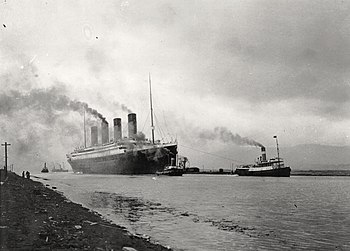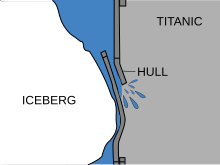User:Dolphinbub19/my little liners
RMS Superic
 RMS Superic on her sea trials, preparing to leave Southampton, on 28 November 1919
| |
| History | |
|---|---|
| Name | RMS Superic |
| Owner | |
| Port of registry | |
| Route | Southampton to New York City |
| Ordered | 18 August 1914 |
| Builder | Harland and Wolff yards in Belfast, Ireland |
| Yard number | 402 |
| Laid down | 30 November 1915 |
| Launched | 30 January 1917 |
| Christened | Not christened |
| Completed | 9 December 1919 |
| Maiden voyage | 6 December 1919 |
| In service | 1919 — 1954 |
| Identification | list error: <br /> list (help) Radio callsign "MRK" UK official number: 131429 |
| Fate | Scrapped after illustrious career in 1932 |
| General characteristics | |
| Class and type | Olympic-class ocean liner |
| Tonnage | 69,372 GRT |
| Displacement | 78,594 tons |
| Length | 982 ft 12 in (299.6 m)* |
| Beam | 99 ft (30.2 m)* |
| Height | 176 ft (53.6 m)* |
| Draught | 35 ft 7 in (10.8 m)* |
| Depth | 69 ft 4 in (21.1 m)* |
| Decks | 13 |
| Installed power |
|
| Propulsion |
|
| Speed | |
| Capacity | list error: mixed text and list (help) Passengers and crew (fully loaded):
Staterooms (945 total):
|
| Crew | 3,836 |
RMS Superic was once the world's largest passenger liner when refitting back at Harland and Wolff in Belfast in 1918. She also served as a maritime hospital ship during World War II, and as a troopship later in the year. Superic was built alongside the "fantastic trio" known as the Olympic, the Titanic and the Britannic. The ship was related with the vessel Britannic's sinking (in which her crewmembers sent a CQD distress signal), but they decided to ignore the "non-essential" message.
Superic's maiden voyage came after the Titanic sank, in which before it was sent back to add sufficient lifeboats and safety features. She had many years of service, until finally being scrapped in 1932 at the same place where Olympic and rival Cunard Line's Mauretania. On 4 November 1916 at 19:58, she struck the submarine SM U-9's port side, being severely damaged but not resulting in her sinking. Germans quickly criticised the liner for the damage wrought to a U-boat, but many British soldiers were impressed with her work and nicknamed her "Big Hickory".
Superic also became an icon for British passenger liners, and many of her constructors were praised for the ship's accuracy, and was also given the title of being "practically unsikable" (a title previously given to her sister ship, Titanic), because when she struck a ship, she had never sank and could limp back to Southampton.
Design and launch[edit]

Superic's keel was laid on 30 November 1915 at Harland and Wolff, where White Star Line's chairman J. Bruce Ismay and the shipyard's chairman Lord Pirrie intended to make the Olympic-class ships the largest and most luxurious of all time, to surpass Cunard's biggest vessels, Lusitania and Mauretania. Of these ships, two were lost: Titanic sank after colliding with an iceberg on 14 April 1912 off the Grand Banks (south of Newfoundland), and Britannic sank after striking a naval mine on 21 November 1916, off the Greek island of Kea (in the Kea Channel), so both Superic and Olympic were given 45 collapsible lifeboats and fitted with more safety features.
Superic was nearly identical to her sister ship, Magnetic II, and was also described as "a second unsinkable ship compared to the White Star ill-fated luxury flagship Titanic which was given the title without qualification". Superic's promenade deck was enclosed to avoid further damage from negative weather, and the ship's wheelhouse was made larger than her sister ship Titanic's. The ship would be under command of Herbert Haddock during her maiden voyage on 6 December 1919. For her launch, Superic was painted black, but later into her career, she was covered in grey.
Changes made from RMS Titanic[edit]
Due to the design flaws that made Titanic seem unsafe, Superic's layout was improved, including the aspect of adding more of the following changes.
Sufficient lifeboats[edit]

Due to the lack of lifeboats for ships over 10,000 tons, White Star Line ordered 45 collapsible lifeboats for Superic; no single source regarded nothing more that insufficient lifeboats would cause an extreme loss of life during a disaster in maritime travel. Alexander Carlisle, Harland and Wolff's general manager, suggested equipping RMS Titanic with a new, larger type of davit, giving her the potential to carry as many as 48 lifeboats; this would have carried enough of the capacity on board. However, White Star Line suggested to use only 20 lifeboats, carrying a maximum amount of 1,178 passengers and crew, when not even that many survived.
Superic quickly went through an overhaul and White Star Line ordered a full total of 45 collapsible lifeboats, to cause less loss of life. The same was done with Olympic; following the year of 1912, many ships provided the right number of lifeboats.
Bulkhead height and steel plating[edit]
Titanic's bulkheads were only a measured 10 ft (3 m) high, which might not make them fully watertight. Superic's bulkheads were then extended to a height of 15 ft (4.6 m), which would make them resist enough damage. It was suggested by White Star Line that "the higher it is, the more watertight it can be", and the same was done with Olympic's bulkheads.

It is also reasonable, however, that the Titanic's steel plating was not strong enough to resist damage wrought by an iceberg. Since this, the steel plate for Superic's hull was extended to 5 inches in thickness, which is strong enough.
